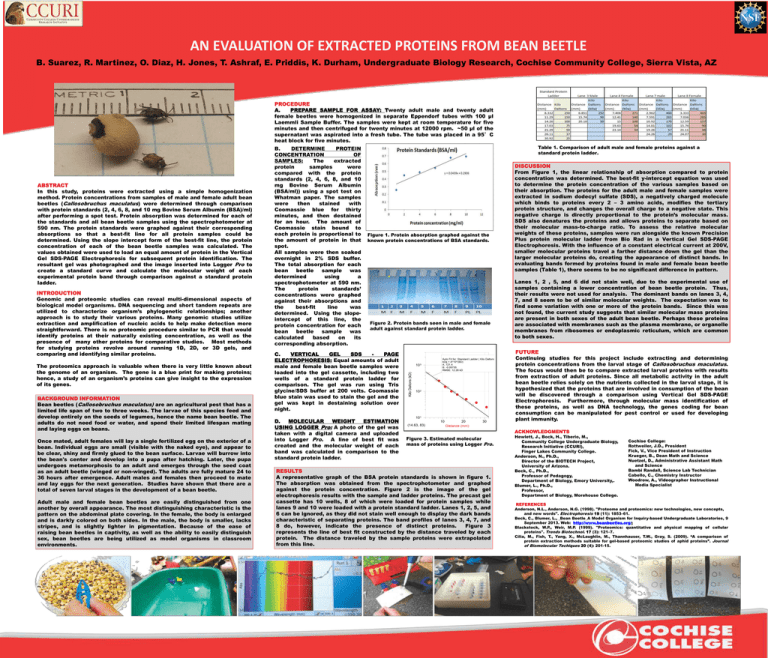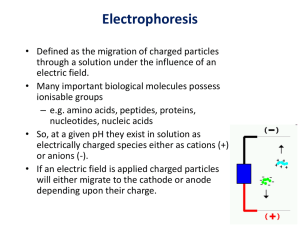
AN EVALUATION OF EXTRACTED PROTEINS FROM BEAN BEETLE
B. Suarez, R. Martinez, O. Diaz, H. Jones, T. Ashraf, E. Priddis, K. Durham, Undergraduate Biology Research, Cochise Community College, Sierra Vista, AZ
PROCEDURE
A.
PREPARE SAMPLE FOR ASSAY: Twenty adult male and twenty adult
female beetles were homogenized in separate Eppendorf tubes with 100 µl
Laemmli Sample Buffer. The samples were kept at room temperature for five
minutes and then centrifuged for twenty minutes at 12000 rpm. ~50 µl of the
supernatant was aspirated into a fresh tube. The tube was placed in a 95°C
heat block for five minutes.
ABSTRACT
In this study, proteins were extracted using a simple homogenization
method. Protein concentrations from samples of male and female adult bean
beetles (Callosobruchus maculatus) were determined through comparison
with protein standards (2, 4, 6, 8, and 10 mg Bovine Serum Albumin (BSA)/ml)
after performing a spot test. Protein absorption was determined for each of
the standards and all bean beetle samples using the spectrophotometer at
590 nm. The protein standards were graphed against their corresponding
absorptions so that a best-fit line for all protein samples could be
determined. Using the slope intercept form of the best-fit line, the protein
concentration of each of the bean beetle samples was calculated. The
values obtained were used to load an equal amount of protein in the Vertical
Gel SDS-PAGE Electrophoresis for subsequent protein identification. The
resultant gel was photographed and the image inserted into Logger Pro to
create a standard curve and calculate the molecular weight of each
experimental protein band through comparison against a standard protein
ladder.
INTRODUCTION
Genomic and proteomic studies can reveal multi-dimensional aspects of
biological model organisms. DNA sequencing and short tandem repeats are
utilized to characterize organism’s phylogenetic relationships; another
approach is to study their various proteins. Many genomic studies utilize
extraction and amplification of nucleic acids to help make detection more
straightforward. There is no proteomic procedure similar to PCR that would
identify proteins at their naturally existing concentration, as well as the
presence of many other proteins for comparative studies. Most methods
for studying proteins revolve around running 1D, 2D, or 3D gels, and
comparing and identifying similar proteins.
The proteomics approach is valuable when there is very little known about
the genome of an organism. The gene is a blue print for making proteins;
hence, a study of an organism’s proteins can give insight to the expression
of its genes.
BACKGROUND INFORMATION
Bean beetles (Callosobruchus maculatus) are an agricultural pest that has a
limited life span of two to three weeks. The larvae of this species feed and
develop entirely on the seeds of legumes, hence the name bean beetle. The
adults do not need food or water, and spend their limited lifespan mating
and laying eggs on beans.
Once mated, adult females will lay a single fertilized egg on the exterior of a
bean. Individual eggs are small (visible with the naked eye), and appear to
be clear, shiny and firmly glued to the bean surface. Larvae will burrow into
the bean's center and develop into a pupa after hatching. Later, the pupa
undergoes metamorphosis to an adult and emerges through the seed coat
as an adult beetle (winged or non-winged). The adults are fully mature 24 to
36 hours after emergence. Adult males and females then proceed to mate
and lay eggs for the next generation. Studies have shown that there are a
total of seven larval stages in the development of a bean beetle.
Adult male and female bean beetles are easily distinguished from one
another by overall appearance. The most distinguishing characteristic is the
pattern on the abdominal plate covering. In the female, the body is enlarged
and is darkly colored on both sides. In the male, the body is smaller, lacks
stripes, and is slightly lighter in pigmentation. Because of the ease of
raising bean beetles in captivity, as well as the ability to easily distinguish
sex, bean beetles are being utilized as model organisms in classroom
environments.
B.
DETERMINE
PROTEIN
CONCENTRATION
OF
SAMPLES:
The
extracted
protein
samples
were
compared with the protein
standards (2, 4, 6, 8, and 10
mg Bovine Serum Albumin
(BSA/ml)) using a spot test on
Whatman paper. The samples
were
then
stained
with
Coomassie blue for thirty
minutes, and then destained
for an hour. The amount of
Coomassie stain bound to
each protein is proportional to
the amount of protein in that
spot.
All samples were then soaked
overnight in 2% SDS buffer.
The total absorption for each
bean
beetle
sample
was
determined
using
a
spectrophotometer at 590 nm.
The
protein
standards’
concentrations were graphed
against their absorptions and
the
best-fit
line
was
determined. Using the slopeintercept of this line, the
protein concentration for each
bean
beetle
sample
was
calculated
based
on
its
corresponding absorption.
Table 1. Comparison of adult male and female proteins against a
standard protein ladder.
Figure 1. Protein absorption graphed against the
known protein concentrations of BSA standards.
Figure 2. Protein bands seen in male and female
adult against standard protein ladder.
Lanes 1, 2 , 5, and 6 did not stain well, due to the experimental use of
samples containing a lower concentration of bean beetle protein. Thus,
their results were not used for analysis. The dominant bands on lanes 3, 4,
7, and 8 seem to be of similar molecular weights. The expectation was to
find some variation with one or more of the protein bands. Since this was
not found, the current study suggests that similar molecular mass proteins
are present in both sexes of the adult bean beetle. Perhaps these proteins
are associated with membranes such as the plasma membrane, or organelle
membranes from ribosomes or endoplasmic reticulum, which are common
to both sexes.
FUTURE
Continuing studies for this project include extracting and determining
protein concentrations from the larval stage of Callosobruchus maculatus.
The focus would then be to compare extracted larval proteins with results
from extraction of adult proteins. Since all metabolic activity in the adult
bean beetle relies solely on the nutrients collected in the larval stage, it is
hypothesized that the proteins that are involved in consumption of the bean
will be discovered through a comparison using Vertical Gel SDS-PAGE
Electrophoresis. Furthermore, through molecular mass identification of
these proteins, as well as DNA technology, the genes coding for bean
consumption can be manipulated for pest control or used for developing
plant immunity.
C.
VERTICAL
GEL
SDS
PAGE
ELECTROPHORESIS: Equal amounts of adult
male and female bean beetle samples were
loaded into the gel cassette, including two
wells of a standard protein ladder for
comparison. The gel was run using Tris
glycine/SDS buffer at 200 volts. Coomassie
blue stain was used to stain the gel and the
gel was kept in destaining solution over
night.
D.
MOLECULAR
WEIGHT
ESTIMATION
USING LOGGER Pro: A photo of the gel was
taken with a digital camera and uploaded
into Logger Pro. A line of best fit was
created and the molecular weight of each
band was calculated in comparison to the
standard protein ladder.
DISCUSSION
From Figure 1, the linear relationship of absorption compared to protein
concentration was determined. The best-fit y-intercept equation was used
to determine the protein concentration of the various samples based on
their absorption. The proteins for the adult male and female samples were
extracted in sodium dodecyl sulfate (SDS), a negatively charged molecule
which binds to proteins every 2 – 3 amino acids, modifies the tertiary
protein structure, and changes the overall charge to a negative state. This
negative charge is directly proportional to the protein’s molecular mass.
SDS also denatures the proteins and allows proteins to separate based on
their molecular mass-to-charge ratio. To assess the relative molecular
weights of these proteins, samples were run alongside the known Precision
Plus protein molecular ladder from Bio Rad in a Vertical Gel SDS-PAGE
Electrophoresis. With the influence of a constant electrical current at 200V,
smaller molecular proteins travel a farther distance down the gel than the
larger molecular proteins do, creating the appearance of distinct bands. In
evaluating bands formed by proteins found in male and female bean beetle
samples (Table 1), there seems to be no significant difference in pattern.
ACKNOWLEDGMENTS
Figure 3. Estimated molecular
mass of proteins using Logger Pro.
RESULTS
A representative graph of the BSA protein standards is shown in figure 1.
The absorption was obtained from the spectrophotometer and graphed
against the protein concentration. Figure 2 is the image of the gel
electrophoresis results with the sample and ladder proteins. The precast gel
cassette has 10 wells, 8 of which were loaded for protein samples while
lanes 9 and 10 were loaded with a protein standard ladder. Lanes 1, 2, 5, and
6 can be ignored, as they did not stain well enough to display the dark bands
characteristic of separating proteins. The band profiles of lanes 3, 4, 7, and
8 do, however, indicate the presence of distinct proteins.
Figure 3
represents the line of best fit constructed by the distance traveled by each
protein. The distance traveled by the sample proteins were extrapolated
from this line.
Hewlett, J., Bock, H., Tiberio, M.,
Community College Undergraduate Biology,
Research Initiative (CCURI),
Finger Lakes Community College.
Anderson, N., Ph.D.,
Director of the BIOTECH Project,
University of Arizona.
Beck, C., Ph.D.,
Professor of Pedagogy,
Department of Biology, Emory University,.
Blumer, L., Ph.D.,
Professor,
Department of Biology, Morehouse College.
REFERENCES
Cochise College:
Rottweiler, J.D., President
Fick, V., Vice President of Instruction
Krueger, B., Dean Math and Science
Nuetzel, D., Administrative Assistant Math
and Science
Bambi Randall, Science Lab Technician
Cabello, C., Chemistry Instructor
Woodrow, A., Videographer Instructional
Media Specialist
Anderson, N.L., Anderson, N.G. (1998). "Proteome and proteomics: new technologies, new concepts,
and new words". Electrophoresis 19 (11): 1853–61.
Beck, C., Blumer, L., Bean Beetle_A Model Organism for Inquiry-based Undergraduate Laboratories, 9
September 2013. Web: http://www.beanbeetles.org/;
Blackstock, W.P., Weir, M.P. (1999). "Proteomics: quantitative and physical mapping of cellular
proteins". Trends Biotechnol. 17 (3): 121–7.
Cilia, M., Fish, T., Yang, X., McLaughlin, M., Thannhauser, T.W., Gray, S. (2009). “A comparison of
protein extraction methods suitable for gel-based proteomic studies of aphid proteins”. Journal
of Biomolecular Techiques 20 (4): 201-15.










